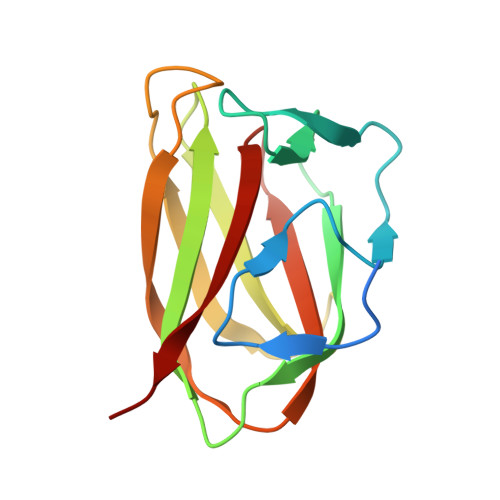Binding Sub-Site Dissection of a Carbohydrate-Binding Module Reveals the Contribution of Entropy to Oligosaccharide Recognition at "Non-Primary" Binding Subsites.
Van Bueren, A.L., Boraston, A.B.(2004) J Mol Biology 340: 869
- PubMed: 15223327
- DOI: https://doi.org/10.1016/j.jmb.2004.05.038
- Primary Citation of Related Structures:
1UY1, 1UY2, 1UY3, 1UY4 - PubMed Abstract:
The optimal ligands for many carbohydrate-binding proteins are often oligosaccharides comprising two, three, or more monosaccharide units. The binding affinity for these sugars is increased incrementally by contributions from binding subsites on the protein that accommodate the individual monosaccharide residues of the oligosaccharide. Here, we use CsCBM6-1, a xylan-specific type B carbohydrate-binding module (CBM) from Clostridium stercorarium falling into amino acid sequence family CBM6, as a model system to investigate the structural and thermodynamic contributions of binding subsites in this protein to carbohydrate recognition. The three-dimensional structures of uncomplexed CsCBM6-1 (at 1.8 A resolution) and bound to the oligosaccharides xylobiose, xylotriose, and xylotetraose (at 1.70 A, 1.89 A, and 1.69 A resolution, respectively) revealed the sequential occupation of four subsites within the binding site in the order of subsites 2, 3, 4 then 1. Overall, binding to all of the xylooligosaccharides tested was enthalpically favourable and entropically unfavourable, like most protein-carbohydrate interactions, with the primary subsites 2 and 3 providing the bulk of the free energy and enthalpy of binding. In contrast, the contributions to the changes in entropy of the non-primary subsites 1 and 4 to xylotriose and xylotetraose binding, respectively, were positive. This observation is remarkable, in that it shows that the 10-20-fold improvement in association constants for oligosaccharides longer than a disaccharide is facilitated by favourable entropic contributions from the non-primary binding subsites.
- Department of Biochemistry and Microbiology, University of Victoria, P.O. Box 3055 STN CSC, Victoria, BC, Canada V8W 3P6.
Organizational Affiliation:





















